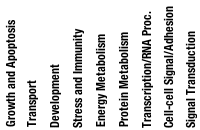Probes from N01B.profile.u50 that match lung development
| Results summary | View all lists in GO:BiolProc | View all genes in N01B.profile.u50 |
| Results summary | View all lists in GO:BiolProc | View all genes in N01B.profile.u50 |
|
The process whose specific outcome is the progression of the lung over time, from its formation to the mature structure. In all air-breathing vertebrates the lungs are developed from the ventral wall of the oesophagus as a pouch which divides into two sacs. In amphibians and many reptiles the lungs retain very nearly this primitive sac-like character, but in the higher forms the connection with the oesophagus becomes elongated into the windpipe and the inner walls of the sacs become more and more divided, until, in the mammals, the air spaces become minutely divided into tubes ending in small air cells, in the walls of which the blood circulates in a fine network of capillaries. In mammals the lungs are more or less divided into lobes, and each lung occupies a separate cavity in the thorax. enrichment: 18.11-fold |
 |
||||||||||||
| Probe ID | Name | G | T | D | X | E | P | R | C | S | Description | ||
| 210513_S_AT | VEGFA | G | D | X | S | vascular endothelial growth factor A | |||||||
| 211886_S_AT | TBX5 | G | D | R | C | T-box 5 | |||||||
| 210973_S_AT | FGFR1 | G | D | P | C | S | fibroblast growth factor receptor 1 (fms-related tyrosine kinase 2, Pfeiffer syndrome) | ||||||